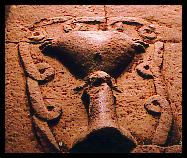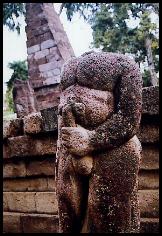

It
is appeared as three terraces in steps which one crosses through
gateways where are the staircases and which end at the third
terrace of approximately 60 m on 40 where is the principal
temple.

Built about 1430, and located at 30 km in the east of Solo, at an elevation of 900 m on the slopes of Gunung Lawu, this temple is called the erotic temple because of its multiple explicit representations.
The
first gateway gives us an idea of what we will see then. Indeed,
one must walk on a superb phallus pointing a pretty reinflated
vulva.

The general impression which emerges from this really particular sanctuary is that one deals here with worships related to sexuality.
One crosses there statues of men without heads (certainly Bima), but not without arguments for in a hand, they hold a club, and in the other they hold their penis in erection.
One
is next to various animals whose a wild boar, also strong-limbed
, and an elephant still better strong-limbed, and on the walls of
the temple, the gargoyles are with the image of Bhima, the legs
wide apart, the male member tended good, and holding a horn of
plenty in the right hand.
One
says about the principal temple that it makes think of the Aztec
temples: a trapezoidal pyramid which rises in steps with a slope
of staircases climbing all length until the top. However, here
there is not this image at all because the staircases are inside,
they are invisible.
Actually,
which one sees, it is a truncated triangle of sunk color, with a
vertical slit in the medium. Considering the context, the symbol
appears very clear to me: it is the representation of an immense
female sex, an immense yoni.

In top of the staircases on the platform was erected an enormous lingam of two meters height , which is now in the national museum of Jakarta, and whose top is surrounded by four balls. These four balls laid out according to the four directions represent, usually, four heads of Shiva symbolizing at the same time its omnipotence and its omniscience. However, in this case, these four balls seem, on the representation opposite, being of the large udders full of milk, obvious symbol of a worship to the fertility.
Therefore, the follower entered the sanctuary as in the original matrix, the initiatic rise of the staircases purified him, he arose in top, regenerated ressuscited.
Arrived close to the lingam, fills up with primordial cosmic emanations , he was not more afraid of nothing, "the force was with him!"
At
foot of the monument, three tables in the shapes of tortoises
were to be used for the offerings.
There
is also, on and around the principal sanctuary and the three
small structures which precedes it several altars comprising by
many panels carved with design of wayang
type. These accounts put Bima in scenes, his birth and his
training, then his search to find his guru.
One
follows also the brother of Bima, Sadeva, in the history drawn
from Sudamala, which tells how it manages to
save Uma which a curse had forced to take the form of Durga.
Another
image which also takes part in this saving ideology and which one
sees several times represented, is that of the Garuda bird in an
episode of Garudeya in which he obtains the
delivery of his mother Vinata. It is known that it is also to
deliver his mother of death that Garuda steals Amrita,
the elixir of immortality.
Built
about 1470, this temple is located at 1500 m altitude on the
slopes of G. Lawu close to the small village of Kadipeso at a few
kilometers in the north of the preceding temple.
In a superb panorama, this complex of seven terraces in steps just like Candi Sukuh contains the representations related to the worship of the fertility by a regénéressence of solar origin.
One
finds there the ithyphallic representations of Bima,
lingams, and symbolic animals , tortoises, bats,
frogs, lizards.
At the foot of the sanctuary, two stone mosaics , that one invites us to cross, represents symbols of the fertility or of hearts of deaths.
One
finds initially the dualistic symbol lingam yoni,
as with the preceding temple, but here, the triangle of the yoni
is covered with nine small carved animals: three frogs in the
center, three lizards in the angles, and in the bisectrices, an
eel, a crayfish, and a small shellfish with the tail in the shape
of dagger, called "mimi". Behind this representation, a
large bat with the spread wings carries on its back a tortoise.
On the tortoise, formerly was erected a large lingam whose top was decorated with four balls like that of Candi Sukuh. There is doubtless a representation related to the death, and to the spirit of the ancestors, and one inevitably thinks of these Vietnamese cemeteries in which the funerary steles are posed on backs of tortoises.
As with Candi Sukuh, one finds many representations of characters in the style "wayang".
The 15th century is that of the massive Islamization of the Javanese population , accentuated by the development of the trade, on hands of the Moslems, Arabs, Indians or Chineses. The Mojopahit Empire is in collapse. Il is necessary to resist physically, by isolating oneself in the mountains where the sanctuaries will henceforth be built. It is also necessary to resist spiritually. A new worship will appear, a tantric worship dedicated to Bima, the Lord of the Mount Bromo, the new sacred mountain, and in which Bima, such our Hercules, will be the hero at the same time fertilisator and saving. His worship will be diffused widely by the wayang which will tell his "works" in the villages of the high plateaus.
Today still, Kasada , the great festival of New Year's day of the Tengger's, precisely takes place on the Bromo mount, at the same date, février / mars, as the greatest festival of Mojopahit, Caitra , the festival of new rice, beginning of the new year.
![]()